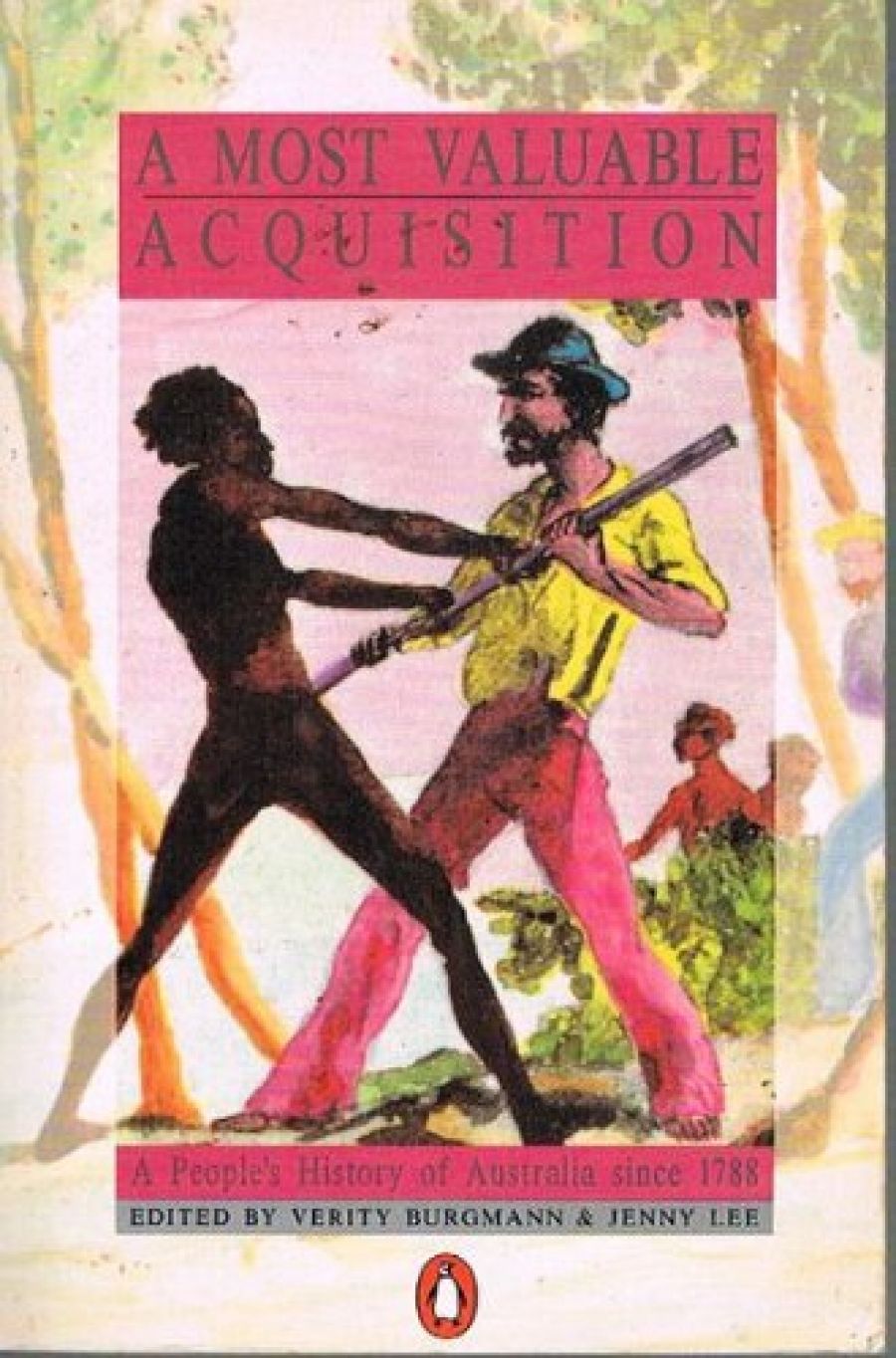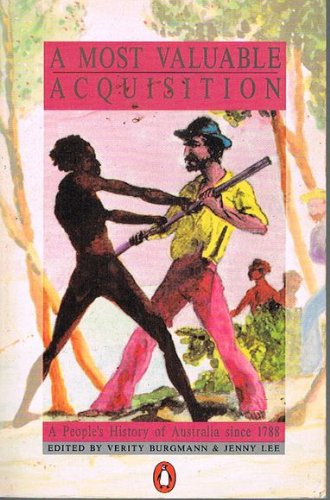
- Free Article: No
- Contents Category: History
- Review Article: Yes
- Article Title: Ploughing the first furrows
- Online Only: No
- Custom Highlight Text:
Women’s fashions change every year. History fashions change every decade. When I was at school and at University history books told me to be grateful for being British. Out on the streets I was told ‘Buy British and be proud of it!’. Times change, brother – as Colin Cartwright, Barry Humphries’ creation, pointed out. Now, in the season of the sere and yellow leaf, I am asked to read a history quite different from what I read when young.
- Book 1 Title: A Most Valuable Acquisition: A People’s History of Australia since 1788
- Book 1 Biblio: McPhee Gribble/Penguin, $16.95 pb, 272 pp
- Book 1 Cover Small (400 x 600):

- Book 1 Cover (800 x 1200):

This first volume of A People’s History opens in a quite different way. This time there is no John the Baptist, no man or woman prophesying that this continent will one day be the proudest possession the British ever acquired or stole. (It would have been unthinkable for our teachers to talk of it as a theft). This time Henry Reynolds opens the people’s story with the words attributed to an Aborigine: ‘White man came look Everything.’
The People’s History is not primarily white man’s history. It begins with Aboriginal history, with the response of the aborigines to the invasion of their country by the white man. Henry Reynolds tells this story superbly. He begins with the Aborigines sighting the great white bird out in the ocean and proceeds to tell the reader the consequences for the Aborigines. So far so good. He is also superb on the problems faced by the Aborigines who tried to adjust their lives to the way of life of their conquerors. The egalitarian, kin-based society of the Aborigines, as he points out, did not ‘equip the blacks with the concepts they needed to comprehend a social order based on private ownership and class power, still less one in which they were placed at the bottom of the pyramid.’ The white man was not just a medium through whom offences came. As Henry Reynolds wisely sees, the white man was one of the actors in a tragedy.
The second chapter is by Barry Butcher and David Turnbull. Their subject is Aborigines, Europeans and the Environment. Opinions will probably differ about their way of looking at the past. The old history, with its ‘goodies’ and ‘baddies’ often lapsed into painting a caricature of the human situation. The new history, the people’s history must also beware of the dangers of lapsing into a different sort of caricature. Here the whites are the ‘baddies’ and the Aborigines the ‘goodies’. There is plenty of material to sustain such a view. The question is: does such history distort the facts? Butcher and Turnbull try hard not to slip into the language of the Pharisee.
So does Diane Bell, who writes the chapter: ‘We are Hungry for our Land’. She is not writing about the hopes and passions of the white man but about the hopes of the Aborigines to regain the land stolen from them by the white man. Some, Diane Bell tells us, would say that Australia is ‘mortgaged’ as ‘a suitable piece of real estate ripe for development by the multi-nationals’. But, she continues, for the one per cent of the population who are Aboriginal, the land is theirs. She writes the story of who originally owned Australia, and who owns it now.
The other chapters cover the subjects which Marxists and their sympathisers believe to be the stuff of human history. Philip McMichael tells us about the convict labour force, giving his chapter the catchy title: ‘Brutalized, Beggared and Bought.’ He gets straight into the flogging. Chris McConville tells the story of the emigrant free workers. Andrew Markus has a well-informed and morally impeccable chapter on the immigrants in the twentieth century. Jenny Lee tells us about the apron-strings of Empire. Rick Kuhn writes all about Workers, Capital and the Protection Racket. With such a heading the reader needs only one guess at the contents and tone of the chapter.
And so it goes on. Granted the values of the authors, all the chapters are well done. They all draw our attention to material left out of previous works on Australian history. They are all very, very worthy. The difficulty for a writer in such a vein is how to be worthy without being dull. History is written to entertain and to instruct. There is an abundance of instruction in these pages, but something is missing. There are no flesh-and-blood human beings. Humanity is almost missing.
This is a pioneer work of its genre. Those who plough a first furrow must do the rough work. Others will come in later to break up the clods and prepare the soil for a spring sowing. Human beings will not permanently disappear from the pages of history. Trotsky’s History of the Russian Revolution, Karl Marx’s Eighteenth Brumaire or his Mass Struggles in France are proof if needed, that Marxist history or people’s history is not always as free of human interest as a frog is of feathers. It is time that someone wrote that kind of history in Australia. To do so a writer needs the gifts of a Brian Fitzpatrick or a Humphrey McQueen. The writers in this volume have prepared the way. They have played the overture; now the curtain must rise on the first act in the writing of the new history.
We have been told that in the kingdom of heaven there are many rooms. We can at least hope that the same is true in the temple of Clio. The writers of narrative history do not have a monopoly on the best places in that temple. So far they have proved their staying power. Genesis, Homer, Herodotus, Thucydides, Gibbon etc, etc, etc, have lived on. Now newcomers are taking an important place in the temple. Clio has room for all who set out to tell us why we are as we are. Clio also seems to like historians who can show us something of what goes on in the human heart.


Comments powered by CComment